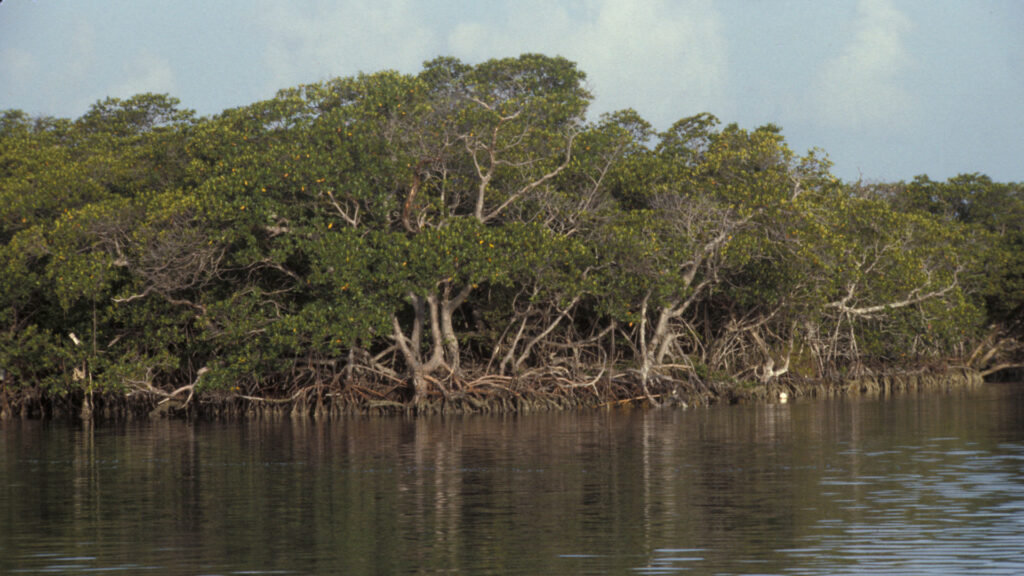By Camila Solari-Byrne
Miami is currently facing a climate crisis, including rising sea levels, stronger storms and coastal erosion. One of Florida’s best natural defenses – mangrove forests – has been rapidly declining due to urban expansion, environmental degradation and diseases.
Mangrove forests provide habitats for diverse marine life, improve water quality, protect coastlines and store carbon dioxide. Although traditional conservation efforts have made a difference, they struggle to keep up with environmental threats.
Artificial intelligence (AI) is emerging and can provide promising solutions to the current habitat loss. By integrating AI into mangrove restoration and conservation efforts, Miami can protect these critical ecosystems while advancing the United Nations’ Sustainable Development Goals, particularly its goals on taking action to combat climate change and conserving marine resources.

AI-driven technologies are already transforming conservation efforts worldwide. In Kenya, AI-powered satellite monitoring has helped track illegal deforestation and poaching in real time, allowing law enforcement and conservationists to take action quicker.
A similar approach can be applied to Miami’s mangroves, using AI-enhanced satellite imagery and drones to monitor deforestation, illegal land use and ecosystem health. Kenya’s successful use of these practices demonstrates their potential to increase mangrove protection from damaging human activities.
Moreover, AI models can analyze intricate and large amounts of environmental data to predict which areas are most at risk, and recommend targeted restoration strategies. As stated in the research paper “AI and the Environment: Toward Sustainable Development and Conservation,” “AI can revolutionize our approach to safeguarding the environment.”
In Miami, this could mean optimizing mangrove replanting efforts by identifying ideal locations for new growth based on water salinity, soil quality and tidal patterns.
Although some critics argue that AI is too expensive and complicated for large-scale conservation projects, cost-effective AI applications are already being implemented in developing nations. This is a clear demonstration that these technologies can be scaled and adapted to different environments. Additionally, public-private partnerships can fund AI-driven conservation projects, similar to Kenya’s carbon credit system, which incentivizes local communities to protect forests by making conservation financially practicable.
Another common concern is the ethical implications of AI in environmental monitoring. Privacy issues are a common concern that arises when AI-powered surveillance is used to track land use. However, if implemented transparently and with community involvement, AI can become a long-term benefit rather than a threat. By ensuring that conservation initiatives are community-driven and ethically managed, Miami can avoid the risk of AI misuse while securing its benefits in protecting local mangrove forests.

If there is no intervention, Miami’s coastline will continue to erode, placing thousands of homes and businesses at risk. Mangroves continue to be the best natural shoreline protection despite their decline in population. AI provides an innovative solution to not only prevent further damage, but to restore what has been previously lost. By combining AI’s predictive capabilities, along with traditional conservation methods, Miami can significantly improve in climate resilience and marine ecosystem restoration.
Miami has the opportunity to embrace new technology to maintain a stable coastline and prosper as an environmentally friendly city. AI is a revolutionary tool that is currently being adapted in both developing and existing nations, offering practical, scalable and immediately implementable solutions for innovative AI-driven conservation. AI is a revolutionary tool that is being adapted into developing and current nations.
Utilizing its innovative AI-driven conservation ideas is not out of reach; it is a practical, scalable solution that can be implemented today. Policymakers, scientists, and community leaders must work together to integrate AI into conservation efforts and secure funding for technological advancements. By taking action now, we can protect our mangroves, safeguard our city, and set an example for coastal communities worldwide. The future of Miami’s community, homes and businesses depends on it.
Camila Solari-Byrne is a first-year student in the Honors College at Miami Dade College. Banner photo: Mangroves near Everglades City. (Riandi, CC BY-SA 3.0, via Wikimedia Commons).
Sign up for The Invading Sea newsletter by visiting here. To support The Invading Sea, click here to make a donation. If you are interested in submitting an opinion piece to The Invading Sea, email Editor Nathan Crabbe at nc*****@*au.edu.



